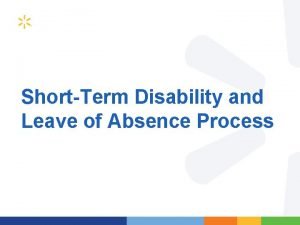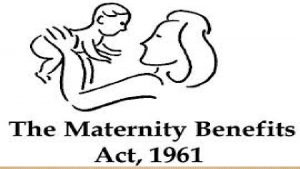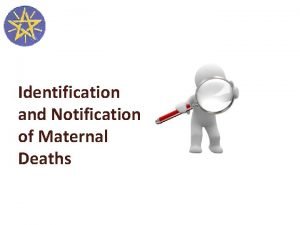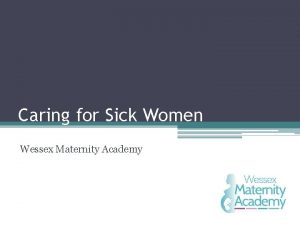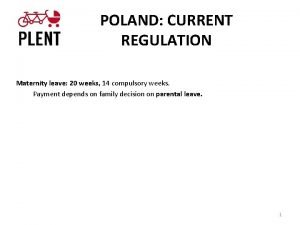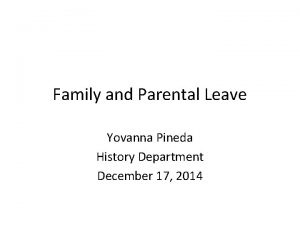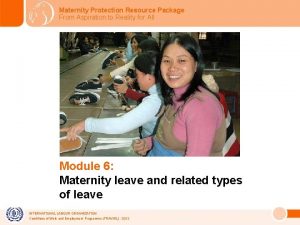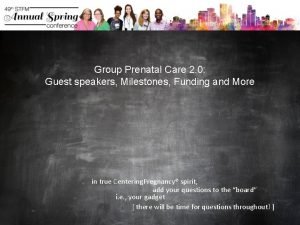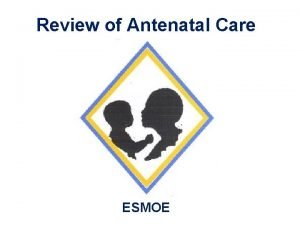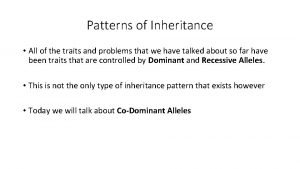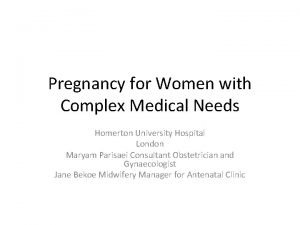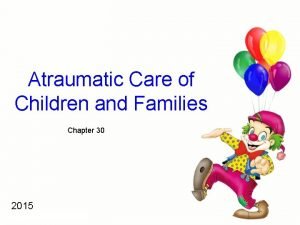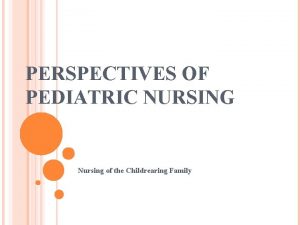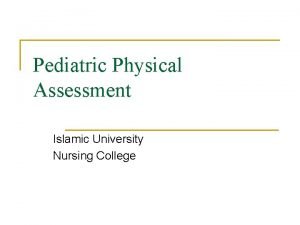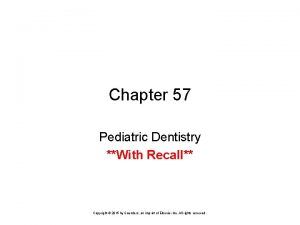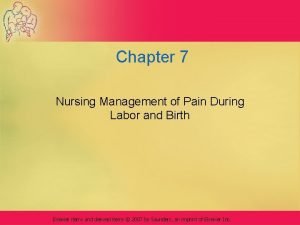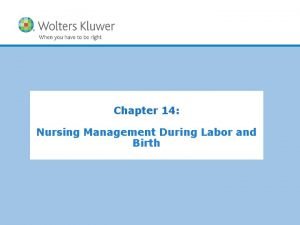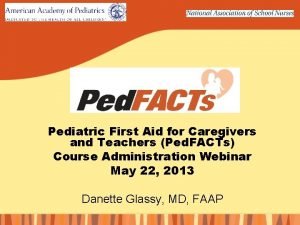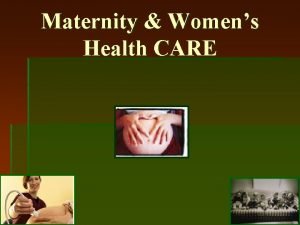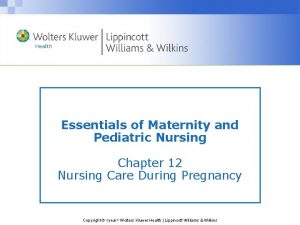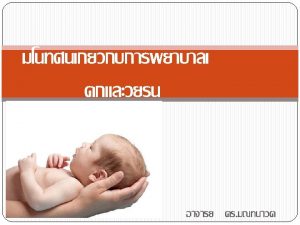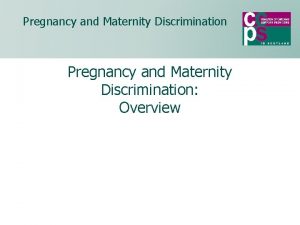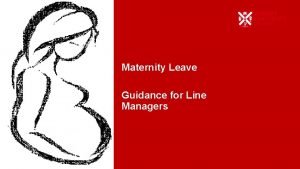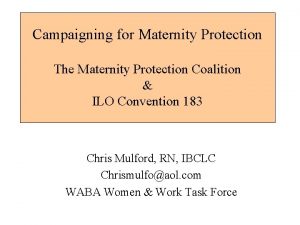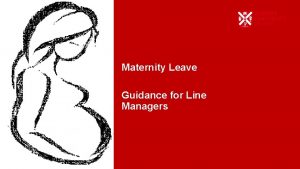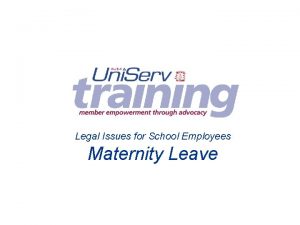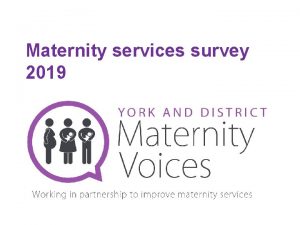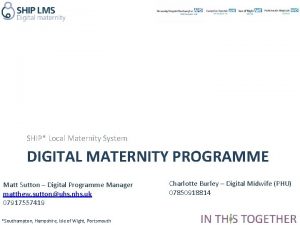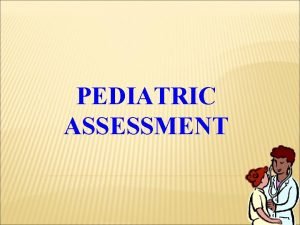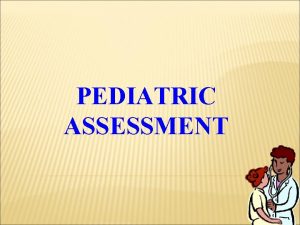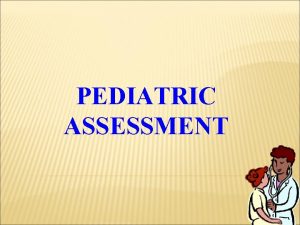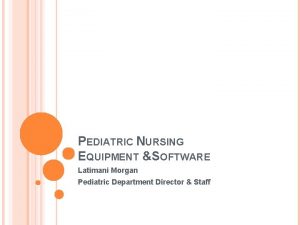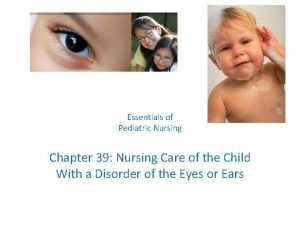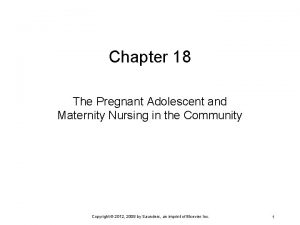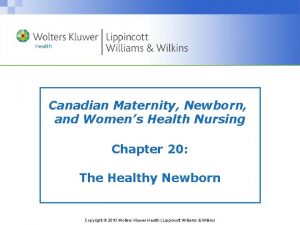Maternity and Pediatric Nursing Chapter 12 Nursing Management





























- Slides: 29

Maternity and Pediatric Nursing Chapter 12 Nursing Management During Pregnancy Copyright © 2013 Wolters Kluwer Health | Lippincott Williams & Wilkins

Risk Factors for Adverse Pregnancy Outcomes • See Table 12. 1 Copyright © 2013 Wolters Kluwer Health | Lippincott Williams & Wilkins

Preconception Care • Immunization status • Underlying medical conditions • Reproductive health care practices • Sexuality and sexual practices • Nutrition • Lifestyle practices • Psychosocial issues • Medication and drug use • Support system Copyright © 2013 Wolters Kluwer Health | Lippincott Williams & Wilkins

1 st Prenatal Visit • Establishment of trusting relationship • Focus on education for overall wellness • Detection and prevention of potential problems • Comprehensive health history, physical examination, and laboratory tests Copyright © 2013 Wolters Kluwer Health | Lippincott Williams & Wilkins

Comprehensive Health History • Reason for seeking care – Suspicion of pregnancy – Date of last menstrual period – Signs and symptoms of pregnancy – Urine or blood test for h. CG • Past medical, surgical, and personal history • Woman’s reproductive history: menstrual, obstetric, and gynecologic history Copyright © 2013 Wolters Kluwer Health | Lippincott Williams & Wilkins

Menstrual History • Menstrual cycle – Age at menarche – Days in cycle – Flow characteristics – Discomforts – Use of contraception Copyright © 2013 Wolters Kluwer Health | Lippincott Williams & Wilkins

Menstrual History (cont. ) • Date of last menstrual period (LMP) • Calculation of estimated or expected date of birth (EDB) or delivery (EDD) – Nagele’s rule • Use first day of LNMP 11/21/12 • Subtract 3 months 8/21/12 • Add 7 days 8/28/12 • Add 1 year 8/28/13 = EDB – Gestational or birth calculator or wheel – Ultrasound Copyright © 2013 Wolters Kluwer Health | Lippincott Williams & Wilkins

Obstetric History • Gravida: a pregnant woman – Gravida I (primigravida): first pregnancy – Gravida II (secundigravida): second pregnancy, etc. • Para: a woman who has produced one or more viable offspring carrying a pregnancy 20 weeks or more – Primipara: one birth after a pregnancy of at least 20 weeks (“primip”) – Multipara: two or more pregnancies resulting in viable offspring (“multip”) – Nullipara: no viable offspring; para 0 Copyright © 2013 Wolters Kluwer Health | Lippincott Williams & Wilkins

Obstetric History (cont. ) • Terminology – G (gravida): the current pregnancy – T (term births): the number of pregnancies ending >37 weeks’ gestation, at term – P (preterm births): the number of preterm pregnancies ending >20 weeks or viability but before completion of 37 weeks – A (abortions): the number of pregnancies ending before 20 weeks or viability – L (living children): number of children currently living Copyright © 2013 Wolters Kluwer Health | Lippincott Williams & Wilkins

Question • Is the following statement True or False? • A woman who is “para 1” is a woman who has given birth once after 20 weeks' gestation Copyright © 2013 Wolters Kluwer Health | Lippincott Williams & Wilkins

Answer • True • Rationale: Primipara (para 1) is a woman who has given birth once after 20 weeks' gestation. Copyright © 2013 Wolters Kluwer Health | Lippincott Williams & Wilkins

Physical Examination • Vital signs • Head-to-toe assessment – Head and neck – Chest – Abdomen, including fundal height if appropriate – Extremities Copyright © 2013 Wolters Kluwer Health | Lippincott Williams & Wilkins

Physical Examination (cont. ) • Pelvic examination – Examination of external and internal genitalia – Bimanual examination – Pelvic shape: gynecoid, android, anthropoid, platypelloid – Pelvic measurements: diagonal conjugate, true (obstetric) conjugate, and ischial tuberosity Copyright © 2013 Wolters Kluwer Health | Lippincott Williams & Wilkins

Laboratory Tests • Urinalysis • Complete blood count • Blood typing • Rh factor • Rubella titer • Hepatitis B surface antigen • HIV, VDRL, and RPR testing • Cervical smears • Ultrasound Copyright © 2013 Wolters Kluwer Health | Lippincott Williams & Wilkins

Follow-up Visits • Visit schedule: – Early pregnancy: every 4 to 6 weeks – After 30 weeks’ gestation: every 2 to 3 weeks – After 36 weeks’ gestation: every 1 to 2 weeks Copyright © 2013 Wolters Kluwer Health | Lippincott Williams & Wilkins

Follow-up Visits (cont. ) • Assessments – Weight & BP compared to baseline values – Urine testing for protein, glucose, ketones, and nitrites – Fundal height (see Figure 12. 3) – Fetal movement – Fetal heart rate (see Nursing Procedure 12. 1) • Teaching: danger signs Copyright © 2013 Wolters Kluwer Health | Lippincott Williams & Wilkins

Question • Is the following statement True or False? • A woman who is 24 weeks pregnant would arrange for a follow-up visit every 2 weeks. Copyright © 2013 Wolters Kluwer Health | Lippincott Williams & Wilkins

Answer • False • Rationale: A woman who is 24 weeks pregnant would have follow-up visits scheduled every 4 to 6 weeks until she reaches 30 weeks’ gestation. Copyright © 2013 Wolters Kluwer Health | Lippincott Williams & Wilkins

Assessment of Fetal Well-Being • Ultrasonography (see Figure 12. 4) • Alpha-fetoprotein analysis • Marker screening tests • Amniocentesis (see Figure 12. 5 and Table 12. 3) • Chorionic villus sampling (CVS) • Percutaneous umbilical blood sampling (PUBS) • Nonstress test; contraction stress test • Biophysical profile • Doppler flow studies Copyright © 2013 Wolters Kluwer Health | Lippincott Williams & Wilkins

1 st Trimester Discomforts • Urinary frequency or incontinence • Fatigue • Nausea and vomiting • Breast tenderness • Constipation • Nasal stuffiness, bleeding gums, epistaxis • Cravings • Leukorrhea Copyright © 2013 Wolters Kluwer Health | Lippincott Williams & Wilkins

2 nd Trimester Discomforts • Backache • Varicosities of the vulva and legs • Hemorrhoids • Flatulence with bloating Copyright © 2013 Wolters Kluwer Health | Lippincott Williams & Wilkins

3 rd Trimester Discomforts • Return of 1 st trimester discomforts • Shortness of breath and dyspnea • Heartburn and indigestion • Dependent edema • Braxton Hicks contractions Copyright © 2013 Wolters Kluwer Health | Lippincott Williams & Wilkins

Nursing Management to Promote Self. Care • Personal hygiene • Avoidance of saunas and hot tubs • Perineal care • Dental care • Breast care • Clothing • Exercise (see Table 12. 4) Copyright © 2013 Wolters Kluwer Health | Lippincott Williams & Wilkins

Nursing Management to Promote Self. Care (cont. ) • Sleep and rest • Sexual activity and sexuality • Employment (see Teaching Guidelines 12. 3) • Travel (see Teaching Guidelines 12. 4) • Immunizations • Medications Copyright © 2013 Wolters Kluwer Health | Lippincott Williams & Wilkins

Question • While assessing a woman at 18 weeks’ gestation, which of the following would the nurse report as unusual? A. Urinary frequency B. Backache C. Leukorrhea D. Flatulence with bloating Copyright © 2013 Wolters Kluwer Health | Lippincott Williams & Wilkins

Answer • A. Urinary frequency • Rationale: During the second trimester, urinary frequency typically improves when the uterus becomes an abdominal organ and moves away from the bladder region. Backache and flatulence with bloating are common during the second trimester. Leukorrhea begins in the first trimester and continues throughout pregnancy. Copyright © 2013 Wolters Kluwer Health | Lippincott Williams & Wilkins

Preparation for Labour, Birth, and Parenthood – Perinatal Education • Childbirth education – Lamaze (psychoprophylactic) method: focus on breathing and relaxation techniques – Bradley (partner-coached childbirth) method: focus on exercises and slow, controlled abdominal breathing – Hypno. Birthing: aims for a trance-like state in the woman, decreasing need for medications and minimizing her stress during childbirth – Birthing From Within: stresses self-discovery as the essence of childbirth preparation. Copyright © 2013 Wolters Kluwer Health | Lippincott Williams & Wilkins

Preparation for Labour, Birth, and Parenthood – Perinatal Education (cont. ) • Options for birth setting – Hospitals: delivery room, birthing suite – Birth centres – Home birth • Options for care providers – Obstetrician – Midwife – Doula Copyright © 2013 Wolters Kluwer Health | Lippincott Williams & Wilkins

Preparation for Labour, Birth, and Parenthood – Perinatal Education (cont. ) • Feeding choices – Breastfeeding: advantages and disadvantages – Bottle feeding: advantages and disadvantages – Teaching • Final preparation for labour and birth Copyright © 2013 Wolters Kluwer Health | Lippincott Williams & Wilkins
 Walmart sedgwick number
Walmart sedgwick number 600-8-10 leaves and passes
600-8-10 leaves and passes Legislation related to maternity benefits
Legislation related to maternity benefits Objectives of maternity ward
Objectives of maternity ward Wessex maternity academy
Wessex maternity academy Maternity leave poland
Maternity leave poland Early obstetric warning system chart
Early obstetric warning system chart Ut austin maternity leave
Ut austin maternity leave Why is maternity leave important
Why is maternity leave important Maternity bitmoji
Maternity bitmoji Maternity benefit act 1961 notes
Maternity benefit act 1961 notes Esmoe
Esmoe There is a practical joker in the maternity ward
There is a practical joker in the maternity ward Woman within maternity
Woman within maternity Homerton maternity helpline
Homerton maternity helpline Female nude for the decoration of bristol club
Female nude for the decoration of bristol club Trends in pediatric nursing
Trends in pediatric nursing Modern concept of paediatric nursing
Modern concept of paediatric nursing Modern concept of child care ppt
Modern concept of child care ppt Child nursing definition
Child nursing definition Atramatic care
Atramatic care Atrumatic care
Atrumatic care Perspective of pediatric nursing
Perspective of pediatric nursing Pediatric nursing definition
Pediatric nursing definition Pediatric physical assessment nursing
Pediatric physical assessment nursing Chapter 57 pediatric dentistry recall
Chapter 57 pediatric dentistry recall Cataracts ncp
Cataracts ncp Chapter 7 nursing management of pain during labor and birth
Chapter 7 nursing management of pain during labor and birth Chapter 14 nursing management during labor and birth
Chapter 14 nursing management during labor and birth First aid for caregivers
First aid for caregivers
